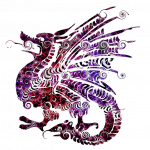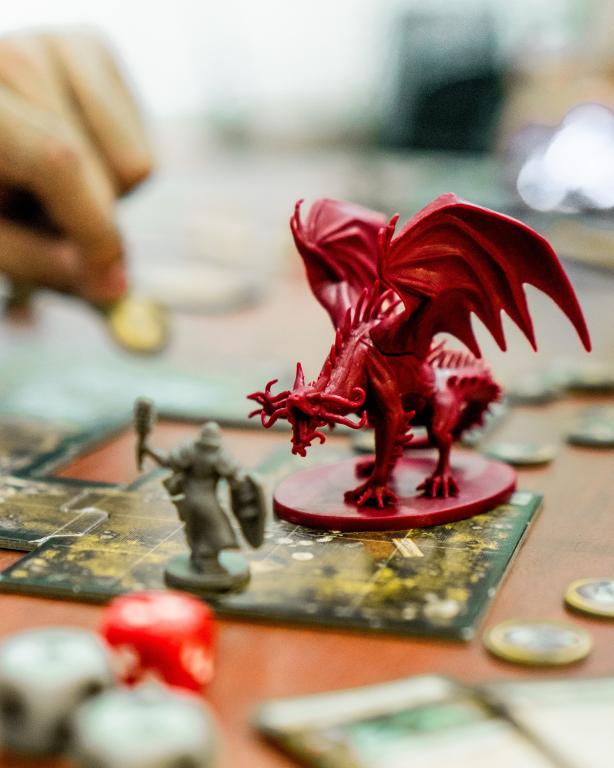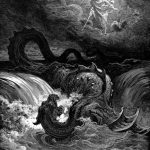
In my previous post, I talked about Leviathan in the Old Testament and located it as “some sort of serpenty sea monster, perhaps resembling a dragon, with multiple heads.” But I also alluded to the benefit of this information in helping to interpret Revelation. And so, to the New Testament we turn!
Ancient Snake in the Garden?
Interpreters have long equated the ancient serpent of Revelation 12 with the serpent of Genesis 3. And, since John explicitly calls his serpent “Satan,” then people assume that the serpent in Genesis 3 was some sort of manifestation of Satan. But what if that’s not the serpent that John was referring to? What if he had a different serpent in mind—one that his first century audience would have been very familiar with?
If you’ve read my first post you probably know where I’m going with this. But humor me for a second. If we compare the serpent in Genesis 3 with the one in Revelation 12 we find that there are very few similarities. In fact, the only clear parallel is that they are both called “serpent,” and John makes that association secondarily. This beast in Revelation is primarily a dragon that is bent on the destruction of God’s people. The serpent in Genesis 3 is a land-dwelling snake that has a rational conversation with Eve and is never called Satan. Not quite the same thing is it? When John calls this frightening, powerful dragon “that ancient serpent” it seems like a stretch to think he was trying to point readers back to the far less imposing snake in Genesis 3.
Ancient Serpent in the Sea
So what other serpent of old might have better parallels to the dragon in Revelation 12? You already know the answer—Leviathan.

Compared to a dragon—check.
Seven heads—check.
Does battle with God—check.
We have already seen that Leviathan is a slithering dragon creature associated with chaos who opposed the shalom that God has created this earth to enjoy. In the ancient world, the dragon or sea monster represented the evil that threatened God’s creation. So when Old Testament writers reference of Leviathan, they did so with the purpose of displaying God’s power to conquer it. This scary monster that people in Job’s days feared and dreaded, was nothing compared to the power of God. As opposed to the other deities from surrounding nations, the God of Israel was not threatened or scared of this beast.
This message of power and control over all of creation was one that John’s original audience needed to hear! And this is the message he brought them. As frightful as this dragon in Revelation 12 appeared, it could not consume the woman, it could not conquer the angelic host, and eventually it will be thrown into the lake of fire.
Unravelling the images
The key to understanding this passage—and all of Revelation for that matter—is grappling with John’s figurative imagery. John is not talking about beasts, dragons, seals and trumpets. He is using these vivid pictures to talk about something else—Roman persecution of Christians in the first century. John draws upon any illustration at his disposal and applies that image to the idolatrous, evil Roman empire, along with the corrupt religious system that does its bidding.
In this chapter, John makes a complex move—he layers his images. We start with the dragon. Without being explicit, he basically calls Rome a dragon of chaos. During this period, the Roman Empire, spearheaded by their ruthless Caesars, were destroying God’s good creation in the form of the saints—God’s faithful Kingdom citizens. Rome was as frightening and destructive to Christians as Leviathan was to the ancient Near East. So, though early Christians may have feared the Roman Empire, John wants to encourage them to be faithful. Just as God made Leviathan his plaything, God was also in control of this beast.
But there’s another layer. While the dragon is Rome, it is also Satan. Or, perhaps, a Satan. The purpose of the Satan in the Old Testament was to verify whether people were truly righteous, pious, and faithful for the right reasons. (A fuller discussion of the function of Satan can be found in Season 1, Episodes 16-20 of the After Class Podcast). The late first century church had plenty of temptation to play both sides:
To split their allegiance between the Roman Empire and the Kingdom of God.
To attempt to appease God and Caesar
To avoid persecution by saying and doing the right things
But just as the Satan in Job wanted to verify that Job was authentically pious, perhaps he is trying to authenticate the faith of these Christians. His tactics have not changed all that much. The Satan sent destruction and death against Job. The Roman Empire brought the same things against Christians. So we might suggest that Satan, in the form of the Roman Empire, was testing Christians to see whether they would “curse God and die” or whether they would seek the blessedness of dying because of their faith.
Encouraging through artistry
So the dragon is, at the same time, Leviathan, Satan, and Rome. Like a tapestry, John is going to weave together different threads to form a cohesive whole. He is bringing all of these images together for one reason—encouragement.
Just as God domesticated Leviathan so he will bring this 7 headed beast to heel.
Just as God defeated the beast from the sea in Daniel so he will defeat this dragon.
The reader is encouraged to see a final victory over the dragon, and everything it represents—evil, chaos, and corruption. After all, in the new heaven and earth there will no longer be a sea (21:1). And so there will be no dragon of chaos to threaten God’s new creation and all the peace and wholeness that comes with it.
In confidence that the dragon would be tamed, the early Christians could be encouraged to remain faithful, even in the face of tremendous fear and persecution.

















